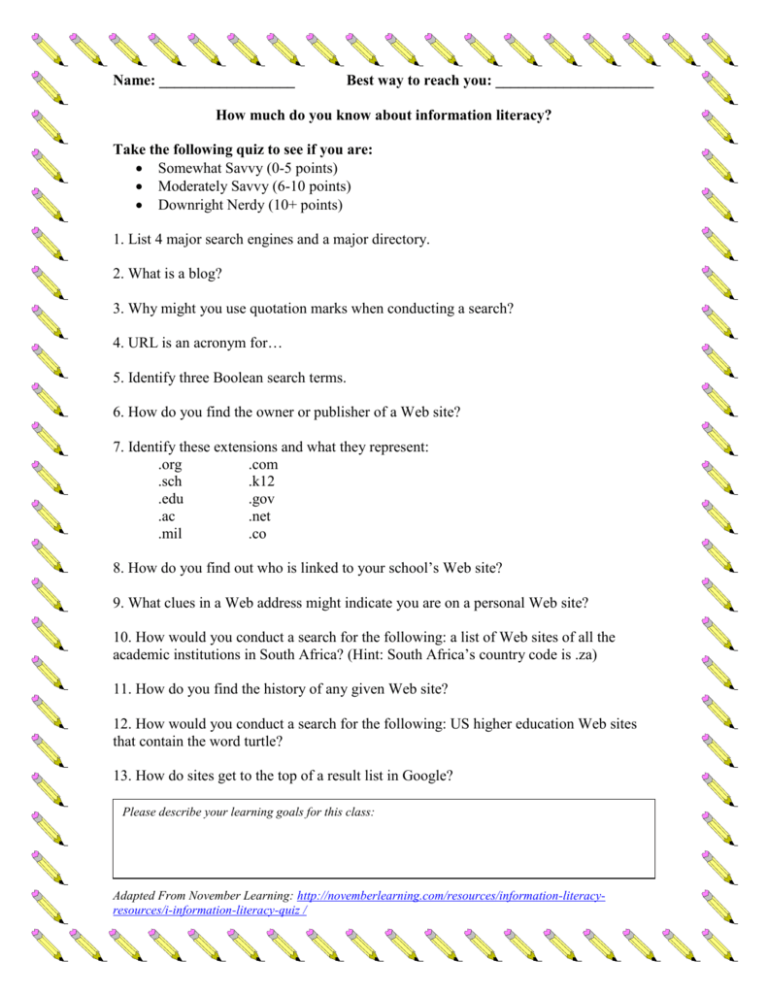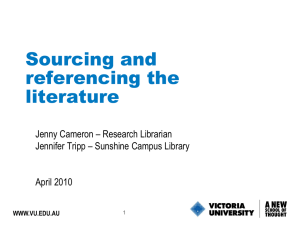Info Literacy Quiz
advertisement

Name: __________________ Best way to reach you: _____________________ How much do you know about information literacy? Take the following quiz to see if you are: Somewhat Savvy (0-5 points) Moderately Savvy (6-10 points) Downright Nerdy (10+ points) 1. List 4 major search engines and a major directory. 2. What is a blog? 3. Why might you use quotation marks when conducting a search? 4. URL is an acronym for… 5. Identify three Boolean search terms. 6. How do you find the owner or publisher of a Web site? 7. Identify these extensions and what they represent: .org .com .sch .k12 .edu .gov .ac .net .mil .co 8. How do you find out who is linked to your school’s Web site? 9. What clues in a Web address might indicate you are on a personal Web site? 10. How would you conduct a search for the following: a list of Web sites of all the academic institutions in South Africa? (Hint: South Africa’s country code is .za) 11. How do you find the history of any given Web site? 12. How would you conduct a search for the following: US higher education Web sites that contain the word turtle? 13. How do sites get to the top of a result list in Google? Please describe your learning goals for this class: Adapted From November Learning: http://novemberlearning.com/resources/information-literacyresources/i-information-literacy-quiz / Answer Key: 1. List 4 major search engines and a major directory. We won’t attempt to list them all here. For a list of search engines, directories, meta-search engines and all their functions, check www.searchenginewatch.com or Wikipedia’s list of search engines. If you are looking for “kidcentric” type search tools, try NoodleTools: NoodleQuest Search Strategies Wizard: http://www.noodletools.com/noodlequest and Tekmom: http://www.tekmom.com/search/ Follow-up Activities for Teachers and Students: Try to find a subject specific database in your area of expertise. Give students sample research problems from which they access NoodleTools to help them select appropriate search tools. 2. What is a blog? Blog is short for weblog – it is literally a log of the Web. Follow-up Activities for Teachers and Students: To see a blog in action go to: This blog started as a literary discussion forum on “The Secret Life of Bees” by Sue Monk Kidd (she even joined in the discussion!) http://weblogs.hcrhs.k12.nj.us/bees/ 3. Why might you use quotation marks when conducting a search? Use “quotation marks” to ensure your keywords appear in your search results in the order you have specified. You would use them if you wanted to research a given phrase. For example, if you conduct a search for global warming, a search WITHOUT quotation marks would find sites that include the words “global” AND “warming” – the words do not have to appear together and you will get more hits than you probably want. Follow-up Activities for Teachers and Students: Have students use a search engine such as Teoma: www.teoma.com and search for a phrase, such as renewable resources without quotation marks, then with quotation marks. Have them note the differences in the number of results. 4. URL is an acronym for… Uniform Resource Locator 5. Identify three Boolean search terms. AND, OR, NOT Follow-up Activities for Teachers and Students: Have students create example search queries using Boolean Operators. 6. How do you find the owner or publisher of a Web site? Go to www.easywhois.com and enter the URL of the site you would like to research. Follow-up Activities for Teachers and Students: Have students find owner information for the site www.harrypotter.com 7. Identify these extensions and what they represent: .org – organization .com – company .sch – school (used outside of US) .k12 – most US school sites .edu – US higher ed .gov – US government (add country code for outside US) .ac – higher ed outside of US usually used with country code, example, “.ac.uk” .net – network .mil – US military .co – Company (if paired with a country code, example “.co.uk,” the state of Colorado or the country, Columbia) Follow-up Activities for Teachers and Students: It’s really important that students are familiar with these extensions. Create a match game or have them identify the extension within sample URLs. 8. How do you find out who is linked to your school’s Web site? Go to Google: www.google.com and do a link: command search. In the search box type link:your school’s address. Follow-up Activities for Teachers and Students: This is called searching for external links. You can search for the external links on any Website with the link command. Consider using some of the bogus Web sites. Look for a list on our Information Literacy page. 9. What clues in a Web address might indicate you are on a personal Web site? Look for a tilde “~” or the “%” sign or a personal name “jdoe” or the word “user” after the domain name and the first forward slash “/“ 10. How would you conduct a search for the following: a list of Web sites of all the academic institutions in South Africa? (Hint: South Africa’s country code is .za) Go to Google: www.google.com and type site:ac.za in the search box Follow-up Activities for Teachers and Students: Have students search for subject specific resources around the world using extensions and country codes. For a full list, visit http://goes.gsfc.nasa.gov/text/web_country_codes.html 11. How do you find the history of any given Web site? Use the Wayback Machine. Go to www.archive.org and type the URL of the web site you would like to research into the search box. Follow-up Activities for Teachers and Students: Have students look at the history of the Harry Potter site: www.harrypotter.com. Why has it changed so much over the years? 12. How would you conduct a search for the following: US higher education Web sites that contain the word turtle. Go to Google: www.google.com and type “site:edu + turtle” in the search box. Follow-up Activities for Teachers and Students: Have students search for school web sites in a particular subject area. 13. How do sites get to the top of a results’ list in Google? One factor Google uses to rank sites is popularity. It counts the number of links from sites all around the Web. For example, if a large number of sites has a specific keyword somewhere on their Web site along with a link to a particular site, Google counts the number of times the keyword appears along with the number of links to a particular site. The higher number of links to a site, the higher Google will rank that site on a list of results. There are several additional factors as well, including but not limited to the title of the site, the site’s meta information and the actual content of the site.




